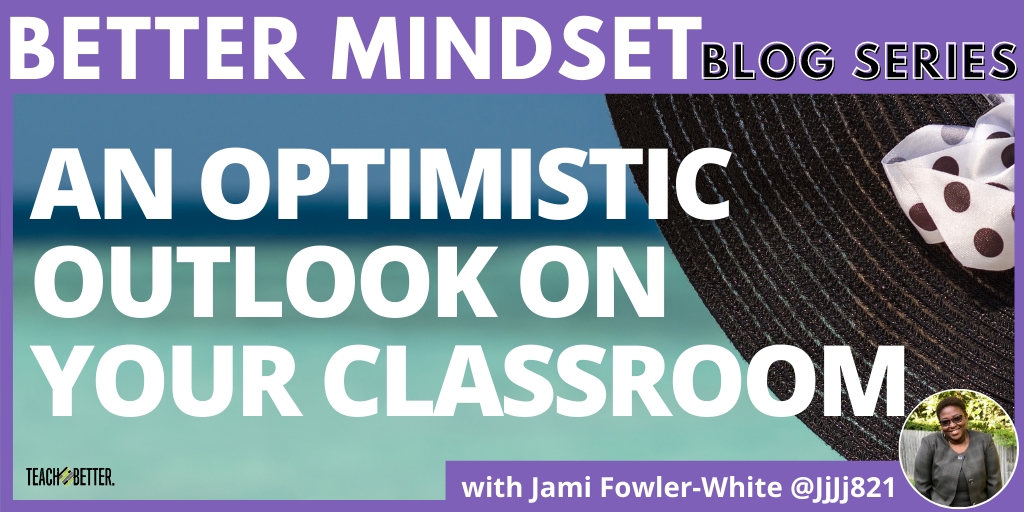TL;DR:
- The tenets of an optimistic outlook on your classroom include having a positive climate and culture.
- Reflect on the level of morale, productivity, and student satisfaction in your classroom.
- Develop actions to optimistically impact students’ views on teaching and learning in your classroom.

Climate and culture are often referred to as the “feel” of the school. Essentially, this feel encompasses the climate which is described as the belief and views that students, parents, and staff have about a school.
It is molded out of patterns of experiences within the school and indicates the values, norms, goals, interpersonal connections, teaching and learning methods, and organizational configuration of a building (Eboka, 2017).
Educators should work to establish a routine that includes checkpoints to help prevent the critical culprits waiting in the shadows from creeping in and negatively derailing a school’s positive culture and climate. Click To TweetThe culture is a significantly well-established paradox that underlies the values held by the people who work and study there and the assumptions pertaining to both the practices and challenging situations.
The culture exerts an exceptionally strong impact over the way an institution operates (Irvin, Meltzer, Dukes, 2007).
When students, parents, and staff are unclear about the expectations within a school, it can disrupt the cultural beliefs, views of all stakeholders. And it disturbs the underlying values within the school culture. This will affect the general atmosphere of the building. Aspects such as morale, productivity, and overall satisfaction will all be affected.
An unfavorable climate oftentimes leads to staff and students feeling that they are not valued or contributing to the success of the organization because a shared understanding of how things should be has not been formed. Usually when this occurs, establishments can fall back on the cultural values which help to guide our day-to-day interactions with others.
Educators should work to establish a routine that includes checkpoints to help prevent the critical culprits waiting in the shadows from creeping in and negatively derailing a school’s positive culture and climate. Those culprits can ultimately lead to detrimental effects on teaching, learning, and the overall academic success of students (Miller, 1981). Everyone contributes to the culture and climate of a school. And teachers should always reflect on the culture and climate of their classroom.
Consider implementing practices to lessen the effects of the three qualities proven to derail the climate and culture of a school/classroom.
#1. Gain an Optimistic Outlook by Implementing Morale Boosters
Everyone wants to feel as if they are in control, are contributing, and respected. Until a connection is made within our brains, people are not engaged. Are you using a diverse number of ways to engage students’ brains? Mixing up content delivery methods—using text features, incorporating audio, embedding a video, reviewing concepts using an interactive app or online tool, taking a virtual field trip, and inviting guest speakers to come and speak to the class—can help to provide variety, provide a vehicle to connect to students’ cultures, and break up the mundane routines of daily instruction.
Have you thought about using stepping stones with students? Stepping stones are action steps or expectations for successfully completing assignments (Fowler-White, 2020). I suggest using these instead of direction slides. This way you can outline academic accountability measures. For example, completing 4 of the 6 actions will result in a 75/C or passing grade. Students can look at the list and decide which grade they want to achieve.
This morale booster is intended to return students’ attention to learning, promote goal setting, help students feel in control of their learning, activate receptors in the brain that form connections, and reduce the feelings of anxiety and being overwhelmed by the number of tasks assigned during the online environment (Schroeder, 2020).
#2. Gain an Optimistic Outlook by Enhancing Classroom Productivity
Learning within the online environment is not the same as learning in a face to face setting. In traditional school settings, many students are motivated to complete their assignments because it is the norm. They can see everyone around them completing their work. How often do you unshare your screen, turn on the side by side feature, or use the grid or gallery feature to spotlight students as they complete academic tasks?
Another way to enhance classroom productivity is to create study pods. In the whole group setting, many students are reluctant to ask questions for various reasons. Consider using breakout rooms or channels, and assign students to a smaller setting when they are completing assignments.
As you monitor these environments, you will find that students will begin to check on each other. They will ask questions, and they will become more productive by turning in their work.
Lastly, students may simply need advice to help them successfully develop virtual work etiquette. Set students on a path of success by modeling your thought processes and practices for drowning out home distractions. Provide strategies for juggling home and school responsibilities, and ways to manage time and prioritize tasks. And promote places such as homework hotline to ensure students know where they can go when they need help.
[scroll down to keep reading]
#3. Gain an Optimistic Outlook by Cultivating Connectedness
Online learning can feel like a solitary experience (Terada, 2020). Students take their cues from you. How comfortable do you feel teaching in the online setting? Many qualities that you used with in-person learning may not transfer well when teaching and learning on online platforms.
Content and delivery should be specifically tailored to promote connection and student engagement.
Instructing online should accommodate students’ personalized learning styles and include leveraging technological tools to help students take in and retain information.
Whenever possible, add a personal touch and incorporate ways to help students feel as if they belong, feel valued, and appreciated. Find ways to check in with students as often as possible. Opening questions serve as a great alternative to greeting students at the door. Scheduling lunch dialogues will allow time for students to have conversations with classmates while they eat lunch at home. And instituting the spotlighting scholars segment—which involves scheduling time for each student to share an item, talent, or hobby with the class—could help students identify things they have in common with peers.
Enhancing optimism, procuring efficiency etiquette, and nurturing connections are essential in building a strong, positive classroom climate, and culture.
If you are interested in learning about other ways to increase your knowledge of virtual engagement practices that help students develop a positive outlook towards teaching and learning, consider completing the Center for Applied Special Technology (CAST) tips for implementing the Universal Design for Learning Guideline Principle of Providing Multiple Means of Engagement or enhancing your knowledge by viewing sessions on DitchSummit.com. Lastly, the Teach Better Academy has an extensive library of courses to increase your online teaching and learning literacy.
Now that you have learned about three distinct qualities that could derail your classroom culture, I challenge you to take a few moments to reflect on the level of morale, productivity, and student satisfaction. Use your findings to develop actions that you can begin using tomorrow to optimistically impact students’ views on teaching and learning in your classroom.
References
Eboka, O. (2017). Influence of School Climate on Teachers Morale in Public Secondary Schools in Delta State.
Fowler-White, J. (2020). Educator Reflection Tip #72: What type of engagement strategies are you using with students and parents.
Irvin, J., Metzer, J., Dukes, M. (2007) Taking Action on Adolescent Literacy. Alexandria, VA: ASCD.
Miller, W. (1981). Staff Morale, School Climate, and Educational Productivity.
Shroeder, S. (2020). How to Help Students Focus on What They’re Learning, Not the Grade
Terada, Y. (2020). 5 Research-Backed Tips to Improve Your Online Teaching Presence
About Jami Fowler-White
Jami Fowler-White is the CEO of Digital PD 4 You, LLC. Over the past two decades, she has served in many capacities in education which include ten years as a classroom teacher, an Instructional Coach, and a Core Advocate with Achieve the Core. She currently mentors First-time and Renewal candidates for the National Board and is a charter member of the National Board Network of Minoritized Educators and Black Women Education Leaders, Incorporated.
Additionally, Mrs. Fowler-White is also a proud member of Delta Sigma Theta Sorority and currently serves as an assistant principal in Shelby County Schools (TN). Fowler-White also provides professional development under the umbrella of the National Board and Digital PD 4 You for schools and districts.
She is the author/coauthor of several books including, Educator Reflection Tips, Volume #1, EduMatch’s Snapshots in Education 2020: Remote Learning Edition, The Skin You are In: Colorism in the Black Community, 2nd Edition, and Educator Reflection Tips, Volume II: Refining our Practice.
Jami blogs at DigitalPD4You.com , has a bi-monthly leadership blog on Insight Advance, and writes a monthly blog entitled the Better Mindset on TeachBetter.com She can be contacted via email at: jwhite.nbct2008@gmail.com and invites you to connect with her on Twitter via @JjJj821




